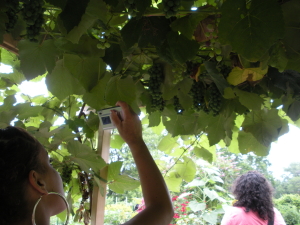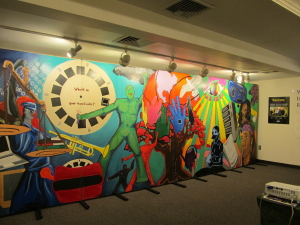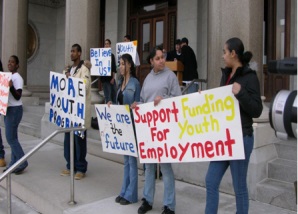Youth PAR Presentations
Many youth who have gone through the Participatory Action Research (PAR) process at ICR have shared their work and research experiences at special public events. These events are opportunities to describe a problem of significant concern in their lives, and to present their research, results, and recommendations for community action to bring about change.

Lead by Example (2010-2015)
“Lead by Example” was part of a teen-driven social marketing campaign to prevent teenage substance use in West Hartford, CT. Teens partnered with ICR to develop social marketing materials (films, website and apparel) based on research findings. Teens presented the research results and campaign materials at town hall meetings. Read more about this project here.
Meriden Youth Action Researchers (2014)
Meriden Youth Action Researchers, with assistance from ICR, conducted mixed method research (using interviews and survey) to understand key factors that contribute to teen substance use in Meriden, Connecticut. Teens presented research findings and recommendations to community stakeholders at several public events. The goal was to build allies and evidence from research findings to develop effective community-based prevention strategies. Meriden Youth Action Researchers were part of a year-round youth employment program of the Meriden Department of Health and Human Services Youth Division. Read more about this project here.

Food Fight (2012)
“Food Fight” was a participatory action research study with Hartford teens in which they examined issues of food justice, food distribution and local food production in their city. The youth conducted research for five weeks to explore whether or not farmers’ markets were friendly toward teens and organized a community presentation to present their findings and recommendations. Read more about this project here.

Race: The Lived Experience (2007)
Hartford teens explored how they experience racism and how images and messages in their environment reflect deep racial biases and stereotyping, resulting in discrimination, internalized racism, and inequity. High school youth action researchers from ICR working with ICR staff and artists Victor Pacheco and Luella Pavey created a mobile mural on racism that reflected findings from the youth research with their peers. The mural and a documentary, Docin’ Da Beat, raised awareness of the continued impact of racism on the well being of youth and adults.

Teen Hustling (2005)
Teens in ICR’s Youth Action Research Program identified teen hustling (illegal sale of drugs or items like bootlegged CDs) as prevalent in the city through their research on this issue, which they identified as negatively impacting their lives. Through surveys and interviews with their peers, youth researchers determined that limited employment opportunities, peer influence, and family financial stress or a lack of communication with parents can cause teens to get involved with hustling. Through a youth employment website, a job bulletin board, informational workshops, and a rally at the state Capitol, teens in the program successfully advocated for more state funding to be allocated to youth employment in CT.
Some of the topics youth addressed in their PAR projects and presented to the public included the following:
- 2008: Personal and group abuse
- 2008: Teen dating violence
- 2006: Teen stress
- 2005: Neighborhood conditions
- 2004: Dropping out of school
- 2002: Supports for lesbian, gay, bisexual, transgender, queer and questioning (LGBTQ) youth of color
- 2002: Negative sexuality
- 2001: Community violence
- 2001: Media portrayal of drug use, sexual activity, and violence
- 2000: Suicidal ideation
- 1999: Reproductive health rights of orphaned underage adolescents
- 1999: Stress associated with exposure to drug use, violence, loss of a loved one, and teen pregnancy
- 1998: Dropping out of school
- 1998: Sex at an early age
- 1998: Peer pressure
- 1997: Sexual harassment
- 1997: HIV risk
- 1997: Self-esteem
- 1996: Teen pregnancy
- 1995-98 UWASA (Urban Women Against Substance Abuse) annual projects
- 1990-93 TARP (Teen Action Research Project) PAR projects for substance abuse prevention
Other Participatory Work
Participatory research methods can use creative approaches to display research models, design effective health interventions, communicate research results, and engage communities in action to improve and enrich their lives. These materials include videos/films, performances, artworks, and more.
I got Mine, did You Get yours?: The Story of Flu Vaccination (2005).
This health promotion video was created by the V.I.P. (Vaccinate for Influenza Prevention) Committee, a coalition of Hartford senior housing residents. It was designed to increase knowledge and positive attitudes toward flu vaccination among low-income, primarily ethnic minority older adults living in senior housing as part of a model health promotion intervention delivered through peer health advocacy campaigns. Read the paper about this project here.
Living Spaces: A Multimedia and Interdisciplinary Program (2003).
An exhibition, performance, and talk that explored the relationship between art, research, and the physical and imagined spaces of our environment. Press Release
Recipes for Life: Celebrating the Lives of Community Elders (2002-2004)
“Recipes for Life” explored the ways in which older adults successfully cope with the aging process. Through an arts-based intervention, older adults shared life experiences and thoughts on successful aging. Read more about this project here.




Add comment